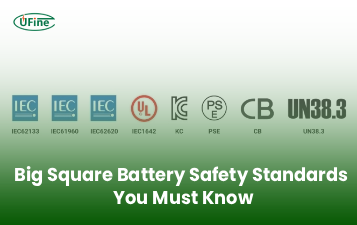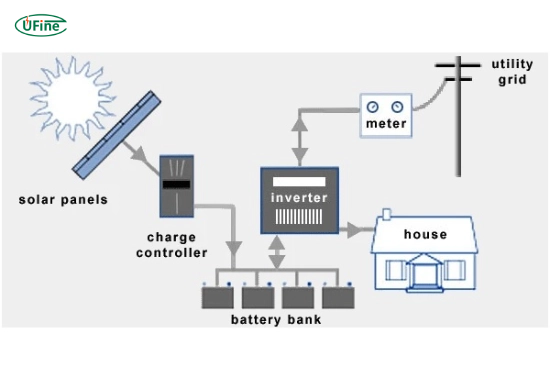
- Part 1. What is a lithium battery for inverter?
- Part 2. How does a lithium battery power an inverter system?
- Part 3. Common types of lithium batteries used in inverters
- Part 4. Key technical specifications you must know
- Part 5. Real-world comparison: Lithium vs Lead-acid batteries
- Part 6. Major advantages of lithium battery for inverter systems
- Part 7. Applications for lithium battery in inverter systems
- Part 8. How to size a lithium battery for your inverter
- Part 9. Installation tips for lithium battery in inverter systems
- Part 10. How to maintain and extend lithium battery life
- Part 11. FAQs about lithium battery for inverter
Looking for the best power storage for your inverter? Lithium offers unmatched performance, a longer lifespan, and better efficiency than traditional batteries. Whether you’re setting up a home backup system, solar power solution, or mobile energy unit, this guide will walk you through everything you need to know about lithium batteries for inverters.
Part 1. What is a lithium battery for inverter?
A lithium battery for inverter is a rechargeable battery that uses lithium-ion technology to store energy. It works with inverters by delivering direct current (DC), which the inverter transforms into alternating current (AC) to power home appliances, RV electronics, or off-grid systems.
Lithium batteries offer much higher energy density, longer life cycles, reduced weight, and faster charging times than traditional lead-acid batteries. This makes them ideal for both small and large-scale inverter applications.
Part 2. How does a lithium battery power an inverter system?
Here’s how the process works:
- The battery stores DC electricity from a solar panel, wall socket, or generator.
- It supplies the stored DC power to the inverter.
- The inverter converts DC into AC power.
- AC power is used to run household appliances such as fans, lights, televisions, refrigerators, and air conditioners.
A lithium battery ensures consistent voltage and high efficiency, which results in smoother and more reliable power delivery.
Part 3. Common types of lithium batteries used in inverters
There are multiple types of lithium-ion batteries, but the two most commonly used in inverters are:
1. Lithium Iron Phosphate (LiFePO4)
- Offers excellent thermal and chemical stability
- Has a very long lifespan, often exceeding 3000 to 5000 cycles
- Safer chemistry reduces the risk of fire or explosion
- Ideal for solar storage, home backup, and RV use
2. Lithium Nickel Manganese Cobalt Oxide (NMC)
- Provides higher energy density in a smaller size
- Often used in portable inverter systems or battery packs
- Slightly shorter lifespan compared to LiFePO4, usually around 2000 cycles
LiFePO4 is preferred for stationary inverter setups due to its superior safety and reliability.
Part 4. Key technical specifications you must know
When selecting a lithium battery for inverter use, it is essential to understand the key specifications:
- Voltage (V): Most inverter systems use 12V, 24V, or 48V batteries. Higher voltage systems are more efficient for larger power loads.
- Capacity (Ah or Wh): Amp-hours or Watt-hours indicate how much energy the battery can store and deliver.
- Cycle Life: Refers to how many complete charge and discharge cycles the battery can handle before its capacity drops below 80 per cent.
- Depth of Discharge (DoD): Lithium batteries can usually be discharged to 90 to 100 percent of their capacity without shortening their lifespan.
- Charge Time: Lithium batteries typically charge within 2 to 4 hours, depending on the charger and system configuration.
- BMS (Battery Management System): Protects the battery from overcharging, deep discharge, overheating, and short circuits.
Part 5. Real-world comparison: Lithium vs Lead-acid batteries
| Feature | Lithium (LiFePO4) | Lead-acid (AGM/FLA) |
|---|---|---|
| Usable Capacity | 90-100% | 50-60% |
| Lifespan (Charge Cycles) | 3000-5000 cycles | 300-800 cycles |
| Efficiency | 95-98% | 70-80% |
| Depth of Discharge (DoD) | Up to 100% | 50% recommended |
| Weight (12V 100Ah) | 12-14 kg | 28-32 kg |
| Charge Time | 2 to 4 hours | 8 to 12 hours |
| Maintenance | No maintenance required | Requires periodic maintenance |
| Cost (12V 100Ah unit) | $400-$800 | $150-$250 |
| Safety | High with BMS | Lower risk of spills and gas |
Although lithium batteries cost more upfront, they offer a much lower cost per cycle and better long-term return on investment.
Part 6. Major advantages of lithium battery for inverter systems
Here are the most important benefits of using lithium batteries with your inverter:
Longer lifespan
A high-quality lithium battery can last over 10 years with proper usage. In contrast, a lead-acid battery may need replacing every two to three years.
Fast charging
Lithium batteries can be charged in 2 to 4 hours using the right charger. This is ideal for solar systems where charging time is limited.
High energy efficiency
They offer up to 98% round-trip efficiency, meaning almost all the energy you input is available.
Compact and lightweight
Lithium batteries are nearly 50 percent lighter than lead-acid batteries of the same capacity, which is crucial for mobile applications.
Zero maintenance
No need to check fluid levels or clean terminals. Lithium batteries come fully sealed and smart-controlled.
Stable voltage output
Voltage remains consistent even during heavy load or deep discharge, which ensures better performance of sensitive electronics.
Part 7. Applications for lithium battery in inverter systems
Lithium batteries can be used in a wide range of inverter-powered systems:
- Home power backup: Provides energy during power outages and ensures critical appliances stay running.
- Solar energy storage: Ideal for storing daytime solar generation for nighttime use.
- Recreational vehicles (RVs): Power onboard appliances and electronics without adding too much weight.
- Off-grid cabins and homes: Offers reliable power where grid electricity is unavailable.
- Marine systems: Reliable in high-humidity and vibration-prone environments.
- Telecom and industrial sites: Ensures uninterrupted power for mission-critical operations.
Part 8. How to size a lithium battery for your inverter
Proper sizing ensures your battery can meet your energy demand. Here is a step-by-step method:
- List your appliances and their power ratings in watts.
- Estimate how many hours each appliance runs per day.
- Multiply to get the total daily energy consumption in watt-hours.
- Determine battery voltage, typically 12V, 24V, or 48V.
- Use this formula:
Battery Capacity (Ah) = Total Watt-hours ÷ Battery Voltage
Example:
If your daily energy need is 3000Wh and you use a 24V battery:
3000 ÷ 24 = 125Ah
Add a 20 per cent buffer to avoid full discharge:
125Ah × 1.2 = 150Ah
You would need a 24V 150Ah lithium battery.
Part 9. Installation tips for lithium battery in inverter systems
Here are the best practices for safe and efficient installation:
- Location: Choose a dry, shaded, and well-ventilated area.
- Mounting: Use brackets or straps to secure the battery.
- Wiring: Use appropriately rated cables for your inverter’s current draw.
- Protection: Install a fuse or circuit breaker between the battery and the inverter.
- Charger compatibility: Ensure your charger or solar controller supports lithium profiles.
- Monitoring: Use a battery monitor or app to track real-time performance.
Always follow the manufacturer’s instructions and consult a certified electrician if needed.
Part 10. How to maintain and extend lithium battery life
Although lithium batteries are low-maintenance, following these tips will maximize their lifespan:
- Avoid deep discharge: Try not to discharge below 10 per cent regularly.
- Keep cool: Store and operate in temperatures between 10°C and 30°C.
- Use compatible components: Ensure chargers and inverters are lithium-compatible.
- Update BMS firmware: Some batteries allow firmware updates for better performance.
- Avoid overloading: Do not exceed the rated power draw of the battery.
With proper care, your lithium battery could serve you reliably for over a decade.
Part 11. FAQs about lithium battery for inverter
How long does a lithium battery last in an inverter system?
Lithium batteries can last 8 to 15 years, depending on quality, usage, and environmental conditions.
Can I replace my lead-acid battery with lithium in my inverter system?
Yes, but you must ensure your inverter and charger are compatible with lithium charging profiles. Some systems may require reprogramming.
Is it safe to use lithium batteries indoors?
Yes. Lithium batteries are sealed, non-toxic, and come with built-in BMS protection. They do not release harmful gases like lead-acid batteries.
How many hours will a 100Ah lithium battery run an inverter?
If you use a 100Ah 12V lithium battery (1200Wh capacity), and your load is 300 watts, it will run for approximately 4 hours.
Are lithium batteries cost-effective for inverters?
Yes. Although the initial cost is higher, lithium batteries offer 3 to 5 times longer life and better efficiency, resulting in lower overall cost per cycle.
Related Tags:
More Articles

Big Square Battery Safety Standards You Must Know
Learn key safety standards for big square batteries to avoid fire risks, shipping delays, and compliance issues in EV, industrial, and energy storage projects.
Big Square Battery Applications in Solar & Industrial Equipment
Big square batteries deliver high capacity, stable output, and long life for solar, industrial, and backup power. Explore key uses and advantages.
Big Square Battery vs Cylindrical Battery: Complete 2025 Guide for EVs, ESS & Industrial Devices
Choosing the right battery is key for designers and engineers. Compare big square vs cylindrical batteries to find the best fit for your application.
How to Choose the Right Big Square Battery for Your Device?
If you’re choosing a big square battery for EVs, solar, or mobility devices, this guide helps you pick the right solution for real-world needs.
Big Square Battery Complete Guide: Types, Uses & Buying Tips
If you are choosing a big square lithium battery for EVs, solar, RVs, or AGVs, this guide helps you select the right NMC, LFP, or LTO solution with examples.



